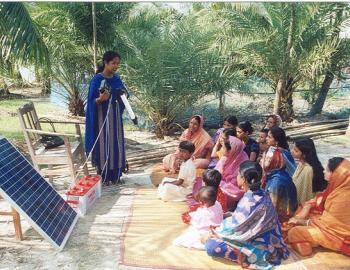Mobilising Investment for NDC implementation in Bangladesh
Mobilising Investment for NDC implementation in Bangladesh
Mobilising Investment for NDC Implementation (MI) was launched by CDKN, SouthSouthNorth and LEDS-GP in 2017. The project works with seven partner countries around the world, namely Bangladesh, Ethiopia, Kenya, Peru, Dominican Republic, Philippines and Vietnam, to accelerate public and private investment in priority NDC sectors and markets.
Context
Bangladesh contributes only 0.35% of global emissions yet has been a vocal advocate of climate leadership and proactive in implementing the GHG reduction commitment targets in its NDC. In 2016, with CDKN’s support, Bangladesh developed action plans for mitigation action in power, transport and industry sectors, as well as an overarching strategy to synergise governmental efforts on NDC implementation. However, financing limitations have restricted the country’s mitigation efforts.
Project activities
During the inception phase, a Scoping Study was undertaken to identify the most fundable sub-sector in relation to Bangladesh’s NDC. The study looked at the potential to support public actors and the private sector to create favourable conditions for private investment in implementing NDCs by de-risking investments and increasing the scale of demand. During this phase, five sub-sectors were shortlisted from the NDC, through research, consultations and interviews.
During phase 1 of the project, sector summaries were used as basis of discussion with high level government officials including the Ministry of Environment, Forests and Climate Change and sectoral ministries (power, industry, transport) to select one sub sector for further work. Unanimously, off-grid solar energy was selected for its scale and potential for future investments.
The project team worked with the Sustainable Renewable Energy Development Authority (SREDA) during phase 2 of the MI project, with the purpose of identifying options for how the public sector could support private investment into the off-grid solar energy sector, and increase private sector awareness of investment opportunities and incentives in the sector. This was achieved by studying the markets, identifying international business model examples from similar markets and exploring key technical, financial and policy barriers to investment in the sub-sector.
Project outputs
The outputs for phase 2 were:
- Business model briefs suggesting short-term improvements to enable rapid market development were developed for solar mini-grids, solar irrigation pumps and solar boat technologies.
- An investment case showcases the investment opportunities that solar mini-grids and solar irrigation pumps hold for financial and investor community in Bangladesh.
- The project also developed a road map to support decision makers in developing necessary incentives to attract private finance and enabling investment environment for private sector.
Phase 3, the final phase of MI project continued to support SREDA in de-risking investment for solar irrigation pumps (SIPs). The project developed a GIS-based analytical tool to support policy makers and investors in identifying the most attractive sites to support the scaling up of the market from around 1,000 SIPs to over 50,000 in the next five to ten years. The aim is to support the sale of surplus power to the main grid by identifying and prioritising ‘meshes’ or ‘clusters’ of SIPs that would be technically and economically feasible for connection to the grid under a modified net metering policy. The outputs for phase 3 were:
- A user-ready visual tool made up of geospatial layers and geo-tagged map to present the recommendations for priority rollout of SIPs, and identification of SIP clusters with high potential for sale of power to the main grid
- A policy note with policy and regulatory recommendations around economic viability of connecting pumps to sell power to the grid, and to consider alternative sources of revenue generation to drive commercial success of SIPs.
Partners: PwC UK, Acclimatise, NACOM, Vivid Economics

